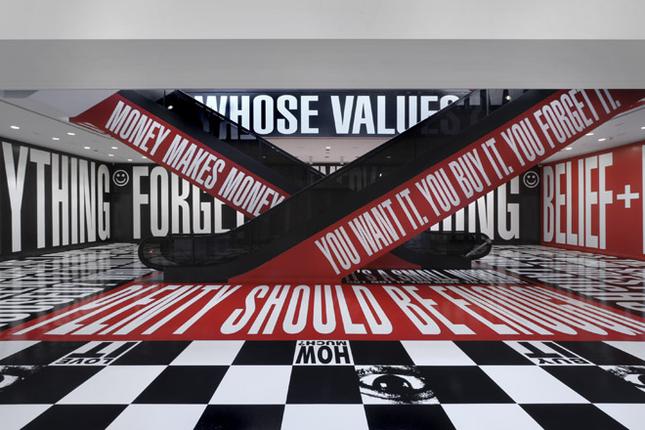Words civilize us. They separate us fair-haired and dexterous animals of intellect from the world of beasts. A baby’s first word is perhaps the first great milestone of their life because words denote the very wonder and intelligence of humankind.
Words can also make us stupid and unbearable.
We often use our words to equivocate, deceive and inflict pain. With them we can distort reality, underscore prejudice, betray one another, and lie to ourselves.
This sort of linguistic relativity—the intention versus perception of our words—is a chance we take every time we open our mouths or put pen to paper. We try to deliver out into the world our thoughts and imaginings, in essence our very selves, and this is perhaps where words seem to falter. Words fail us ¬– or we fail our words – when they do not do justice to what we feel inside.
In her current installation at the Hirshhorn Museum, Barbara Kruger (b. 1945) takes this chance on a monumental scale, releasing her words to form a lexical portrait of our country. With phrases, questions and verbal symbols cramming the walls and floors of the gallery, “Barbara Kruger:
Belief+Doubt” paints a contemporary silhouette of a thoughtful but frustrated American society.
By the 1980s, Kruger was at the forefront of artists who brought photographic illustration and mass media techniques into the mainstream. Pulling from her experience as a magazine photo editor and designer, she reproduced large-scale photomontages from old books and magazines emblazoned with banners of her own text, turning conceptual art into a vibrant public discourse. For instance, across a Rockwellian image of a grade-school girl sweetly poking the curled bicep of her young friend (triggering an image of innocence, sentimentality and the romantic heroism of the 1950s), a bold red banner reads, “We don’t need another hero.”
Since the 1990s, Kruger has focused increasingly on creating environments that immerse the viewer in language. She has employed sound and video projection, orchestrated landscapes of words and, as in this current installation, enclosed her viewers in entire rooms wrapped in text.
However, this installation does not just stand out for its satirical witticism. In “Belief+Doubt” Kruger moves beyond pointing at the vagaries of our social mores in an effort to tackle them head-on.
Descending the escalator to the Hirshhorn’s basement galleries, the trim beneath the ground-floor banisters has written on it four questions. “Whose body?” “Whose beliefs?” “Whose power?” “Whose values?
This is the primer for the sociopolitical labyrinth you are about to enter.
The front wall of the installation, covered from corner to corner in white letters that stretch from floor to ceiling, reads, “Belief + Doubt = Sanity.”
With three words, Kruger offers a hopeful equation that encapsulates our country’s current state of erratic political discord. Though we are at polarizing odds, we all have our tenets and our reservations—and these are often things we struggle to put into words.
Taking up the walls and floors of the large room, including the adjoining gift shop and undersides of the escalators, Kruger’s words become an accumulation of social taboos, moral inevitabilities and political ponderings. “Believe anything. Forget everything. Look for the moment when pride becomes contempt. You want it. You buy it. You forget it.”
The words point to bigger questions beyond themselves. “Who prays loudest? Who is free to choose?”
There aren’t any answers, and maybe these words form the wrong questions, but she is unafraid to ask them. This project is wildly sincere and yet, in a way, unsettlingly ambivalent. These cultural ellipses are bracingly direct, but without the usual soapbox posturing we are inured to witnessing from the political milieu. I think Kruger just wants us to think, to confront our angels and demons in ourselves and in each other, honestly and simply.
“Barbara Kruger: Belief+Doubt” is on view through 2014. For more information visit www.Hirshhorn.si.edu.


